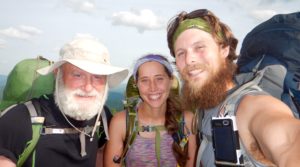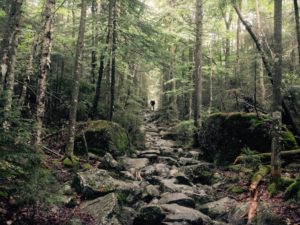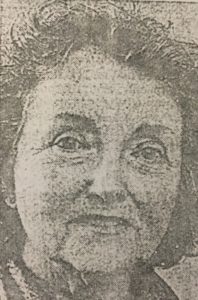On Day 121 of my Appalachian Trail hike, from Georgia to Maine, I woke up at first light, well before 5 a.m. It was still raining.
I blogged my hike on Trail Journals.Com and this is was I wrote about that day:
“Yesterday’s introduction [16.8 miles] to the Whites had taken a lot out of me. The Vikings too. All three of us were accustomed to knocking out 17 to 19 miles a day, sometimes 20–plus, but I had never seen so much bad trail in one day, and so little good.”

“It was Sharon’s (also known now as”Hiking”– Nate is”Viking”) suggestion, but I loved it. Let’s knock off early today. A few hours of up-and-down in this weather and we’ll be wet, cold and tired. Let’s hitch, or get a shuttle, into North Woodstock, NH, get a motel room, and get warm and dry. So that’s what we did.”
“We waited till 8:10 a.m., until the rain slacked off, before beginning what would become an 8.8 eight mile hike. It took us three hours to hike the first four miles – that’s 1.3 mile per hour.”
[Take a look at the video and you’ll see why.]
“New Hampshire started us off today with a 1950-foot climb and followed that with a 1910-foot descent, all in the rain. And high winds on top of the mountains, 50 mph plus.”
“Except for the 6×6 inch “steps” attached to long, steep boulders and the foot holes chiseled in the side of others, I haven’t seen anything new in New Hampshire. The mud, and there’s lots of it, reminds me of Vermont. The steep climbs, North Carolina; the rock hops, Pennsylvania; and the rock climbs and scrambles, New York. The difference is New Hampshire has it all – and very little good trail, so far, to go with it.”

“I’ve just got to learn patience. Slow down. Be satisfied with 12, 13 miles a day. And in a week or so, I’ll be in Maine.”
“Getting off the trail today was the best idea I’ve agreed to in months, since I bailed out of a winter storm at Newfound Gap in North Carolina.”
“Sharon found us an excellent motel, Autumn Breeze. The owner, Ann Albert, came to the trail head to get us, and then washed our clothes. We ate in our room. And ate and ate.”
“Ice cream, too?”
“Oh, yes!”
“Tomorrow’s forecast is for more rain, and a thunderstorm while we are ridge walking above the tree line.”
“We decided to stay put, take a zero. I am at peace with that. You can teach an old dog new tricks.”
Postscript:
Day 122 – Tuesday, June 16, 2015
“What a lazy day.”
“Wonderful!”
“And did it, in fact, rain? Oh, yes. Hard, in the afternoon. And the tops of mountains, where we would have been hiking, were shrouded in mist. Or clouds. Soup of some kind.”
“I doctored my feet – I’ve lost a second toenail.”
“Repaired my boots the best I could with Super Glue.”
“Resupplied.”
“Figured out where I need my wife to send me a supply box – and another pair of boots. My third.”

“And ate. Oh, my – sandwiches, fruit, including watermelon, ice cream, soft drinks and chips, pop corn, orange juice – all the things we can’t get on the trail.”
“Tomorrow, we go back to the trail – 91.3 miles to Maine, 373.1 miles to the top of Mt. Katahdin.“
Coming Monday: The Court of Last Resort
